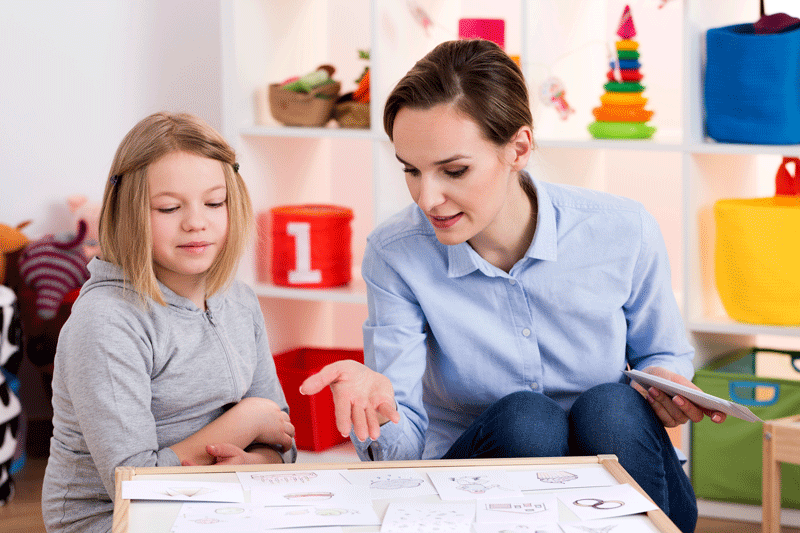You’re going through your workday, and suddenly, the bottom of your foot starts to ache. You stop, untie your shoe, and take it off to see what’s happening. Relief washes over you when your supervisor appears because help has arrived! You start to peel your sock back to show them where you’re hurt, and—your supervisor tells you to put your shoe back on. What? No! You need help! You want to tell them what you need but can’t find the words. When you don’t put your shoe back on, they put your shoe back on themselves. You try several times, only to end up with them tying your shoe again.

The hurt turns to pain over the day, but you endure it. “Maybe I can make it until I go home,” you think to yourself, but then your supervisor places an urgent project on your desk. You can’t take it anymore! You cry. You scream. You rip off your shoe, throw it across the room, and push away your supervisor when they try to put your sock back on. Your coworkers stare. Then, your supervisor finally sees the blister on your heel.
How could the supervisor not see that something was clearly wrong with their employee? In the same way, we sometimes don’t see it when working with our kids. Our hearts break when we realize one of our clients is hurt, but It’s not easy to reduce our client’s distress and perform effectively as ABA professionals when encountering what we perceive as challenging behaviors. Let’s be fair to ourselves—it’s human to become frustrated and even angry when things are thrown or we get hit. What is also important to acknowledge is that our clients are just as frustrated, and it is often because they have little or no effective way to express their needs. We can see this in how functional communication training (FCT) reduces these behaviors (Cooper et al., 2020). However, we also need to train ourselves to be effective listeners so we can close the communication gap and ensure that those we serve can be heard no matter their level of skill.
Communication encompasses several different purposes for our students. This ranges from expressing emotions to asking for what they want or need and sharing information. Our students need effective communication skills to function well in their classrooms and other school environments. Special needs students come with special challenges in effective communication. They rely on their adults to help them both learn functional communication skills and try to do all the things without the benefit of effective communication. These students depend on their adults to not only teach the skills for improved communication but also to translate and interpret for them when their attempts at clear communication fail. Several skills and strategies have been proven to help learners achieve the goals of teaching and interpreting. The most important skill is actively listening. Active listening may seem easy, but it requires practice, focus, attention, and intention to do well. Five steps constitute good active listening:
- Paying attention,
- Showing you are listening,
- Providing feedback,
- Deferring judgment, and
- Responding appropriately.
Steps 1 and 2, paying attention and showing that you are listening, are part of the process of attunement, which Dr. Dan Siegel explains as the ability to hear, see, sense, interpret, and respond to another’s verbal and nonverbal cues in a way that communicates being genuinely seen, felt, and understood. These steps require putting aside anything else competing for your attention, i.e., phones, T.V., books, paperwork, etc., turning toward the other person, even if making eye contact is not possible, and using noises and gestures at appropriate times to show interest, attempts at understanding, and encourage the speaker to continue. Step 3 attempts to understand what the other person is trying to communicate by repeating what you’ve heard, summarizing what you think was intended, and asking clarifying questions to give the other a chance to confirm or correct. This step requires step 4, deferring judgment, which is about putting aside any attempts to put a label on what you are hearing. Understanding and judging are incompatible behaviors. To truly grasp what another person is trying to say, you must be able to put aside one’s own opinion or perspective. Thus, in step 5, the learner has the task of responding appropriately. If one has actively listened, the appropriate response will be one that is accurately connected to the intended message. Active listening is about making sure the person speaking feels understood by a listener. Almost nothing feels better than feeling understood. When a staff person accurately understands the needs and wishes of the student, the staff member can identify appropriate strategies to help the student meet their needs and reduce occurrences of inappropriate behaviors currently being used to meet needs or express frustration and disappointment.
Another important skill for effective communication is emotional literacy- being able to identify, label, and communicate one’s emotions and the emotions of others. Typically, the role of therapists and other caring adults can help teach emotional literacy to students in several ways. Feelings face uses universal emotional expressions to connect emotions and their names and can be adapted to many contexts and activities. Children’s books, shows, and movies provide ample examples of emotional expressions that can be identified and explained. Finally, adults can simply model labeling their own emotions and the child’s emotions in daily communication. Adults can also encourage labeling emotions in debriefing sessions, expanding the child’s reflection, review, and understanding of interpersonal situations. As emotional literacy skills develop, children are increasingly able to understand their needs, articulate wishes, and make better decisions for achieving their interpersonal goals. Teaching emotional literacy also provides the opportunity for the listener to elicit recognition responses from the talker’s facial expression and body language, which suggests an accurate understanding has been grasped. This enables the child to develop relationships, improve problem-solving, and feel connected to their community.
As the field of ABA continues to develop, the concept of individualization has become a more common and important area of focus. There is a movement away from setting “cookie cutter” goals and towards identifying the learner’s specific needs and wants, thereby formulating meaningful, valuable, and life-changing goals. Individualization has also started to evolve in teaching communication skills through multimodal communication. Multimodal communication is a method of teaching and developing communication using a variety of methods, including the use of Augmentative and Alternative Communication Devices (AAC), Picture Exchange Communication System (PECS), Voice Output Communication Aids (VOCA), communication boards, spoken language, gestures or sign language
Typically, only one mode is utilized to teach the learner to communicate, which can be limiting. Some learners may struggle with the complexities of PECS, while others may want to use an AAC device for more than communicating. Multimodal communication can be used to teach the learner the same language in a variety of settings and with a variety of people. A learner can use PECS at home to travel to their caregivers but may find it better to use gestures at school. Another learner may have visual scanning deficiencies but may be able to imitate sign language or spoken language. With a variety of language tools, there is a higher rate of the learner reaching communication success.
Along with multimodal communication comes the acceptance of all attempts at communication, including approximations. If the learner travels to an individual and puts the PECS icon on the table instead of the listener’s hands, the learner is still communicating their need. If the learner states “cookie” instead of “I want cookie,” the listener can still determine what the learner is requesting.
However, what happens if a learner engages in maladaptive behaviors as communication, such as pushing a plate of food on the floor instead of stating “all done”? The behavior can be shaped! The clinician can accept the initial push and model verbally, stating “all done” or using sign language while removing the plate. The next time the learner goes to push the plate, the clinician can redirect the learner to use the modeled form of language until the learner responds independently.
By accepting all modes and approximations of communication, the learner’s frustration and stress can be reduced. This, in turn, can lead to reductions in behaviors, which are often caused by the inability to communicate wants and needs. One major end goal for clinicians is for learners to become happier and more independent. This all begins with teaching learners to communicate in a way that works best for them.
For more information about First Children Services, visit firstchildrenservices.com.
References
Autism Little Learners. (2023, March 30). Multi Modal Communication. Autism Little Learners. https://autismlittlelearners.com/multi-modal-communication/
Communication Community. (2024, August 1). What is Multimodal Communication? (and why use it?). https://www.communicationcommunity.com/what-is-multimodal-communication/
Cooper, J.O., Heron, T.E.,& Heward, W.L. (2020). Applied behavior analysis (3rd ed.). Pearson.
Dougherty, L. (2015). (publication). Multimodal Communication in School-Age Children with Autism Spectrum Disorders (pp. 1–55).









